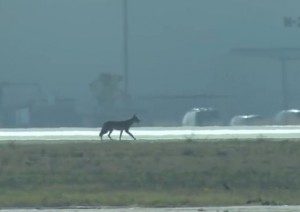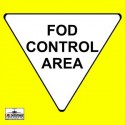 Our grandparents used to think of coyotes as reclusive creatures wandering the western deserts and woodlands. Not any more.
Our grandparents used to think of coyotes as reclusive creatures wandering the western deserts and woodlands. Not any more.
Today these hardy and picturesque predators are just as likely to live in urban areas throughout North America, helping to control the local population of rats, mice and the occasional little yap dog. In October, Gerald R. Ford International Airport in Michigan had to delay several flights after an airliner struck one on a runway.
Over the past quarter century, wildlife strikes on civil aircraft in the USA have increased six-fold, from about eighteen hundred in 1990 to over eleven thousand in 2013. The cost to civil aviation, especially general aviation, runs into the hundreds of millions of dollars annually.
Not surprisingly, populations of large birds, coyotes and deer – which, as a trio, cause the most damage – have increased over that same time period. While minor fluctuations do occur, such as a recent deer decline in some regions, the overall trend is for more birds and animals living and feeding closer to urban areas, including your airport.
When new building or agricultural developments encroach on their traditional habitats, wildlife will adapt as best they can, including migrating to the wide-open spaces of airport property. They also feed at agricultural, fishing, sporting, wildlife refuge, industrial, waste-disposal, and other facilities that expose organic matter to the elements.
The FAA generally recommends wildlife-attracting land uses should not be created within five miles of an airport. Given the powerful local constituencies that support such land uses, you will have a difficult time removing existing projects. But you can still make your voice heard whenever a new land use is proposed that may impact safety.
Regardless of the causes, it is undeniable that the summers are getting hotter and the winters are getting wilder. Changing climate patterns can also shift populations, because most species are used to living within a limited range of temperatures and precipitation. If that range changes, they may migrate away from your airport to a different region, only to be replaced by new species that like the new weather.
While nobody can predicting the weather months in advance or how it will affect complex ecosystems, you can still take practical steps to stay ahead of the curve. Contact colleagues at airports with weather similar to the patterns that you are now beginning to experience. Ask them about the birds and animals that normally cause problems there and how they deal with it. Also get in touch with your local university’s wildlife experts to discuss recent changes in local populations and get their thoughts on what the future might hold.
If you want to learn more and help your colleagues to learn more, participate in the FAA’s voluntary Wildlife Strike Database program. You can report a strike that occurred at your airport, search the database for past strike reports, and read the agency’s annual report on the topic.



